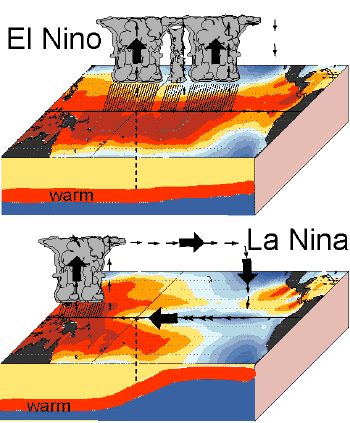 Traditionally
El Nino refers to an increase of ocean surface temperatures over a large
area of the South Pacific. The increase is only a matter of 2° to 7°C,
but this is enough to upset the delicate balance that living organisms
have with their environment. Scientifically, El Nino no longer refers
just to this warming. Scientists have learned that these ocean changes
are coupled with an atmospheric change which starts in the Indonesian
area. This change is called the Southern Oscillation and refers to a
reversal of the western Pacific trade winds which blow east to
west during an El Nino. Normal Pacific trade winds in southern
hemisphere blow west to east. Traditionally
El Nino refers to an increase of ocean surface temperatures over a large
area of the South Pacific. The increase is only a matter of 2° to 7°C,
but this is enough to upset the delicate balance that living organisms
have with their environment. Scientifically, El Nino no longer refers
just to this warming. Scientists have learned that these ocean changes
are coupled with an atmospheric change which starts in the Indonesian
area. This change is called the Southern Oscillation and refers to a
reversal of the western Pacific trade winds which blow east to
west during an El Nino. Normal Pacific trade winds in southern
hemisphere blow west to east.
This ocean/atmosphere condition is called the El
Nino/Southern Oscillation (ENSO for short) events. The winds of
the ENSO event bring warm water to the eastern Pacific Ocean which
creates a living environment that the organisms are not able to cope
with. Increases of temperature, no matter how slight, can cause drastic
results to little organisms that live in the sea. These events usually
recur every 2 to 10 years, with an average of four years and individual
events can last up to 2 years.
|